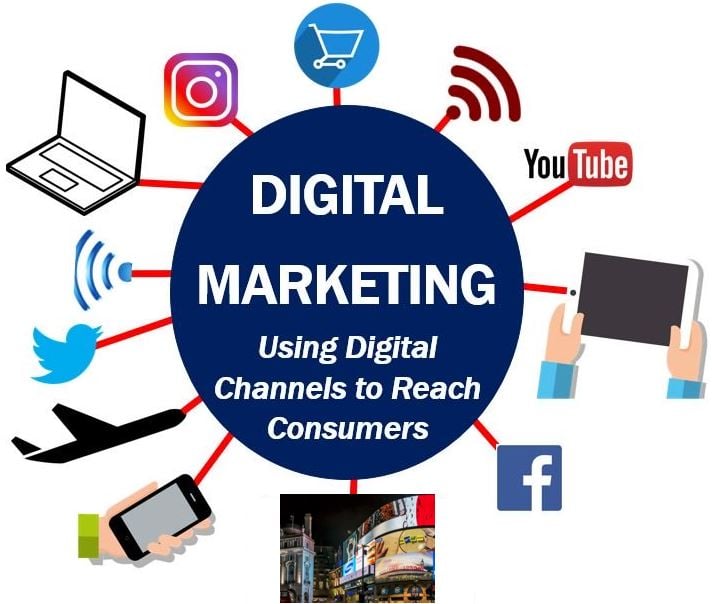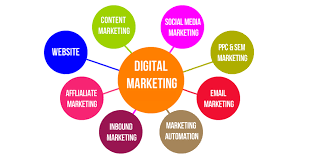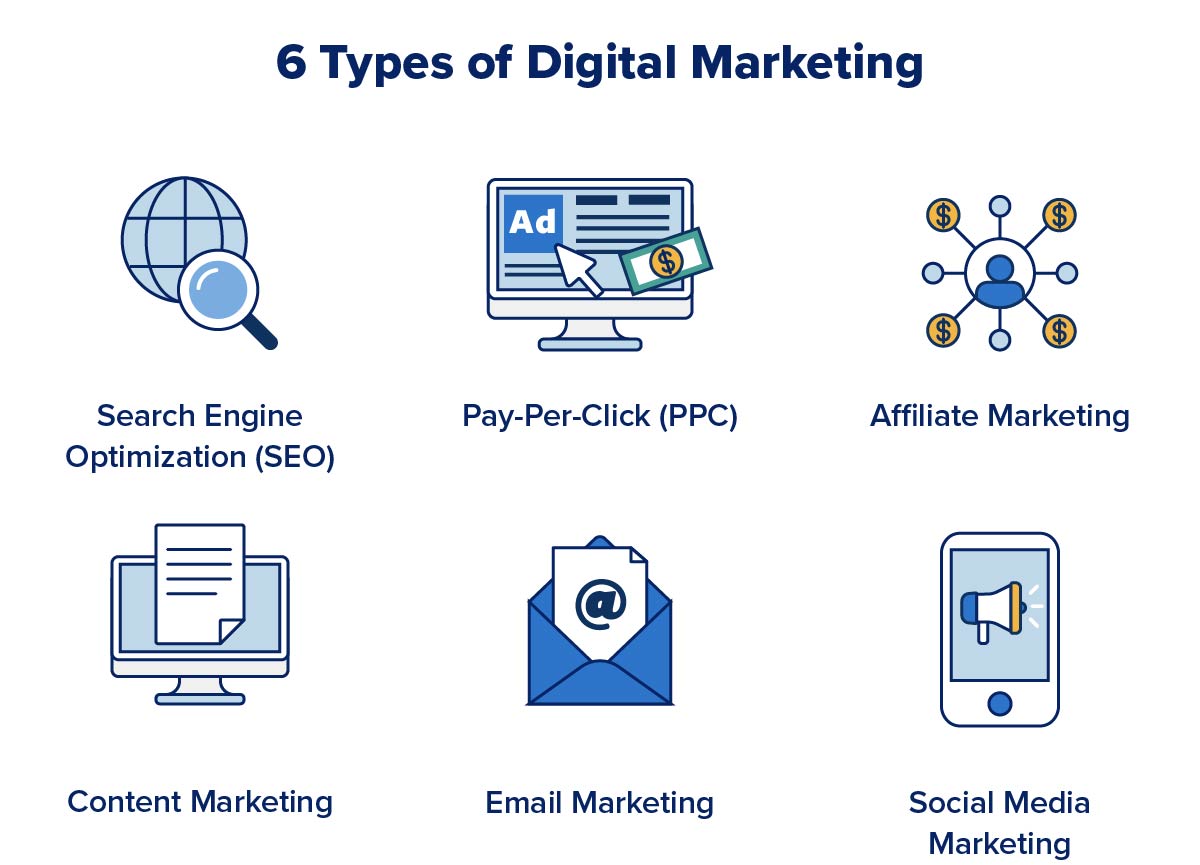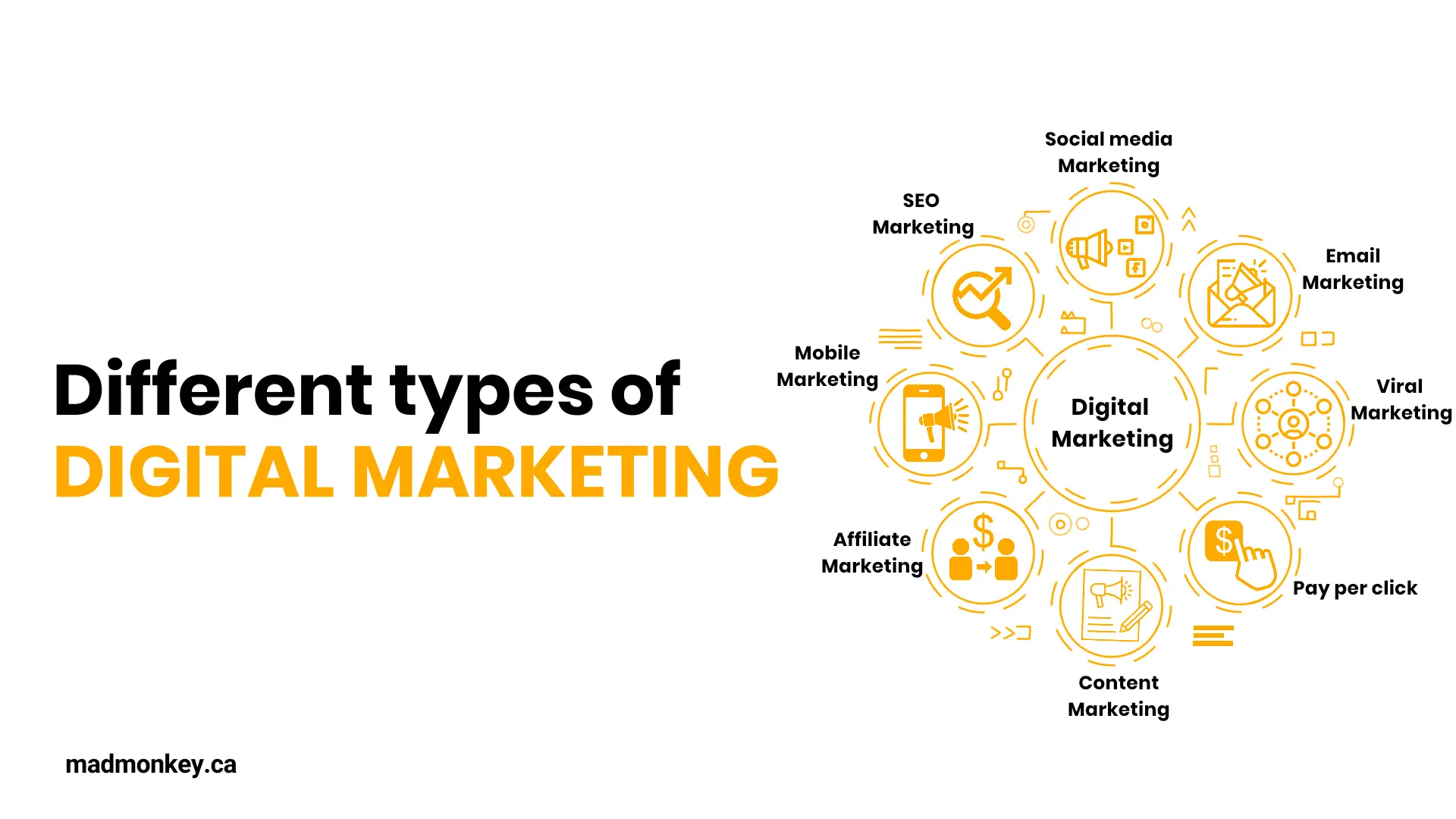Digital Marketing Types
Digital marketing has become an essential component of every business’s growth strategy.
With the increasing use of technology worldwide, the need for digital marketing has also risen significantly.
From small businesses to large corporations, everyone is now turning to digital platforms to promote their products and services. However, there are various types of digital marketing that businesses can employ, each with its unique benefits and drawbacks.
In this blog, we’ll be exploring the different types of digital marketing available in English language and how they can help businesses reach their target audience more effectively.
So whether you’re new to digital marketing or looking to expand your knowledge, keep reading to learn about the various types of digital marketing you should know about.

1. Introduction to Digital Marketing Types
As a digital marketer, it is crucial to be familiar with the different types of digital marketing available to expand your brand’s online presence. In this article, we will explore the various digital marketing types to help you create a comprehensive digital marketing plan.
Search Engine Optimization (SEO) involves optimizing your website’s content to rank highly in search engines such as Google, Bing, and Yahoo. This allows potential customers to find your brand when searching for specific keywords related to your business.
Social Media Marketing leverages social media platforms such as Facebook, Twitter, and Instagram to promote brand awareness, interact with customers, and drive website traffic.
E-Marketing encompasses any type of marketing effort that involves electronic devices and the internet. Email marketing, for instance, involves sending promotional and advertising messages to subscribers on your email list.
Content Marketing is a cornerstone of digital marketing, involving the creation and sharing of valuable, relevant, and consistent content to attract and retain an audience.
Influencer Marketing is the process of partnering with social media influencers to promote your brand through sponsored content. This can help increase brand exposure and credibility among their followers.
Email marketing involves sending personalized emails to customers and subscribers with the objective of driving sales, increasing brand loyalty, and maintaining customer retention.
Video Marketing involves creating engaging video content to promote your brand, products, and services. Platforms such as YouTube, Vimeo, and TikTok can be utilized to post videos to engage with your target audience.
Pay-Per-Click (PPC) Advertising involves placing ads on search engines or social media platforms and paying a fee for each click on the ad. This type of advertising can help drive traffic to your website, increase conversions, and generate leads.
Finally, Mobile Marketing involves creating mobile-optimized content, websites, apps, and ads to target and engage mobile users.
By understanding and utilizing these different types of digital marketing, you can create an integrated digital marketing plan that will help your business to grow and achieve its goals.
2. Understanding Search Engine Optimization (SEO)
As a digital marketer, I know from experience that Search Engine Optimization (SEO) is one of the most critical aspects of a successful online presence. In this section of my blog, I want to explain briefly what SEO is, why it’s important, and how it fits into the vast ecosystem of digital marketing.
At its core, SEO is the practice of optimizing your website and its content to achieve higher rankings on Search Engine Results Pages (SERPs) for relevant keywords and phrases that are relevant to your business or niche. The goal is to attract more qualified traffic to your website and improve brand visibility, trust, and authority.
To do this, digital marketers use a variety of different techniques, like on-page optimization, link building, keyword research, and content marketing, as well as constantly staying up-to-date with algorithmic changes and emerging trends in the search engine industry.
Though SEO is just one piece of the digital marketing puzzle, it’s perhaps the most essential one. It’s the foundation upon which all of your other marketing efforts will stand, and it’s vital to understand it thoroughly if you want to be successful online.
In the other sections of this blog, I’ll dive deeper into other essential aspects of digital marketing, like social media marketing, content marketing, email marketing, video marketing, influencer marketing, pay-per-click advertising, and mobile marketing, each valuable in its way.
The thing to remember is that no single digital marketing channel exists in a vacuum. All of these channels work together in a complex and dynamic ecosystem that is always evolving. By understanding how SEO plays into this ecosystem and taking an integrated and holistic approach to your online marketing efforts, you can achieve sustainable growth and success in today’s digital landscape.

3. Social Media Marketing: Tips for Success
As a digital marketer, I know that social media marketing is a crucial part of any successful digital marketing strategy. It’s the perfect way to connect with your audience and build a community around your brand. In this section, I want to share some essential tips for success in social media marketing.
First and foremost, it’s essential to know your target audience. Understanding who they are, what they want, and how they engage with social media is critical in crafting an effective social media marketing campaign. Once you have that knowledge, you can create engaging and relevant content that resonates with your audience.
Social media marketing is all about building relationships. Encourage your audience to interact with your brand by creating conversations around your content, responding to comments, and engaging in social media chats. It’s also equally important to monitor your social media pages regularly and actively participate in discussions.
Visual content is also a powerful tool in social media marketing. Eye-catching graphics, videos, and images can grab your audience’s attention, making them more likely to engage with your brand. Therefore, ensure that you prioritize creating visually appealing content.
One of the most significant advantages of social media marketing is its cost-effectiveness. You can use social media advertising to reach an even wider audience and drive traffic to your website.
In conclusion, social media marketing is a powerful tool that, when used effectively, can significantly boost your online store sales. It’s all about understanding your audience, creating engaging content, building relationships, and effectively utilizing social media advertising. By combining this with other digital marketing strategies such as SEO, e-marketing, content marketing, influencer marketing, email marketing, video marketing, PPC, and mobile marketing, you can take your digital marketing effort to the next level.
4. E-Marketing: A New Era in Digital Marketing
As a seasoned digital marketer, I’ve seen the industry evolve rapidly over the past two decades. The emergence of e-commerce and the rise of online marketing have forever changed the landscape of how we do business. In this blog section, I want to focus on e-marketing, which I believe represents a new era in digital marketing.
E-marketing, also known as email marketing, is a powerful tool for businesses to reach out to potential and current customers with personalized messages. This form of marketing has been around for a while, but its effectiveness has been amplified in recent years due to advancements in technology and data analytics. With e-marketing, businesses can communicate with their target audience in real-time, providing updates on products, services or promotions.
One of the main advantages of e-marketing is its low cost when compared to other marketing channels. Email marketing allows businesses of all sizes to reach a wider audience within a shorter timeframe. Additionally, e-marketing is measurable, which means marketers can track and analyze engagement rates, open rates and click-through rates to optimize their campaigns and increase ROI.
There are certain best practices that businesses should follow to make the most of their e-marketing campaigns. For example, personalized emails have been found to generate a higher level of engagement than generic mass emails. Also, it’s important to have a clear call-to-action (CTA) in the email to guide the users towards the desired action.
While e-marketing can be a powerful tool, it should not be relied upon as the sole marketing channel. Instead, it should be integrated with other channels like social media marketing, content marketing, and video marketing to create a holistic marketing strategy. Each of these channels serves a different purpose, and when integrated, they work together seamlessly to enhance overall marketing effectiveness.
In conclusion, e-marketing is a game-changing trend in the digital marketing landscape. Email campaigns are targeted, personalized, and cost-effective, and when combined with other digital channels, businesses can create powerful marketing campaigns that generate leads, drive conversions, and fuel business growth. As a digital marketer, I’m excited about what the future holds for e-marketing and can’t wait to see where this new era takes us.

5. Content Marketing: A Cornerstone of Digital Marketing
As I continue to explore the different types of digital marketing, I cannot help but emphasize the importance of content marketing in today’s business landscape. Content marketing is more than just creating and sharing valuable content to attract and retain customers. It’s a strategic approach to marketing that focuses on delivering relevant and consistent content to a specific audience.
When done correctly, content marketing can have a significant impact on a business’s bottom line. It can increase brand awareness, generate leads, and drive conversions. But how do you make sure your content marketing strategy is effective? Here are a few tips:
First, define your target audience. Who are you trying to reach? What are their pain points? What challenges do they face? By understanding your audience’s needs and interests, you can create content that resonates with them and addresses their concerns.
Second, create a content calendar. Consistency is key when it comes to content marketing. A content calendar can help you plan and organize your content, so you’re not scrambling to come up with ideas at the last minute. It can also ensure that you’re publishing content on a regular basis, which can help increase your visibility and engagement.
Third, diversify your content types. Don’t just stick to blog posts or articles. Experiment with different formats, such as videos, infographics, podcasts, and social media posts. Different types of content can appeal to different audiences and keep your content fresh and interesting.
In conclusion, content marketing is a crucial component of any digital marketing strategy. By understanding your audience, creating a content calendar, and diversifying your content types, you can make sure your content resonates with your audience and drives results. Stay tuned for my upcoming blog sections as I delve into other types of digital marketing.
6. Influencer Marketing: How to Get Noticed
As a digital marketer, I know the importance of staying ahead of the curve with new trends and strategies. In the realm of digital marketing, influencer marketing has become a major player in recent years. For those unfamiliar, influencer marketing involves partnering with individuals who have a large following on social media platforms to promote your brand or product.
So, how do you get noticed in the crowded world of influencer marketing? One important factor is to identify the right influencers for your brand. Look for individuals who align with your brand values and have a following that is relevant to your target audience. Don’t just focus on the number of followers, but also the engagement and interaction they receive on their posts.
Once you have identified potential influencers, it’s important to approach them in a professional manner. Clearly outline your objectives and expectations for the partnership, as well as any compensation or perks that will be provided. Remember, influencers are often inundated with partnership requests, so it’s important to stand out with a tailored and personalized approach.
Finally, be sure to track and measure the success of your influencer marketing campaigns. Look for metrics such as engagement, reach, and conversions to determine the effectiveness of the partnership. This will not only inform future influencer partnerships, but also allow for the optimization and improvement of current campaigns.
In summary, influencer marketing is a powerful tool in the world of digital marketing. By identifying the right influencers, approaching them professionally, and tracking success metrics, you can ensure a successful partnership and make your brand stand out in the crowded influencer space.

7. Email Marketing: The Power of Personalization
As a digital marketer, I know the power of email marketing to reach a targeted audience and drive conversions. But it’s not enough to simply send mass emails to your subscribers – personalization is key to unlocking success.
In fact, personalized email campaigns deliver 6 times higher transaction rates than non-personalized campaigns. With the right data and segmentation tools, you can tailor your messaging based on customer behavior and preferences.
But personalization goes beyond simply using someone’s name in the subject line – it’s about creating relevant content that speaks directly to their needs and interests. This requires a deep understanding of your audience and their journey with your brand.
To create effective personalized email campaigns, start by segmenting your audience based on demographics, behavior, and engagement with your brand. Use dynamic content to automatically populate sections of your emails with relevant information based on their interests.
Incorporate personalization into your subject lines, pre-header text, and email copy to catch your subscribers’ attention and encourage them to open and engage with your emails.
By embracing the power of personalization in your email marketing campaigns, you can build stronger relationships with your subscribers and drive higher engagement and conversions for your brand. It’s just one piece of the digital marketing puzzle, but it’s an important one.
8. Video Marketing: Creating Compelling Content
As a digital marketing professional, video marketing is one of my favorite tools for creating compelling content. It’s no secret that videos are hugely popular, with millions of people consuming them daily on social media platforms like Facebook and Twitter.
Video marketing allows businesses to tell their story in a creative and engaging way, while also reaching a wider audience. Through videos, companies can demonstrate their products, showcase their brand personality, and even provide behind-the-scenes glimpses into their operations.
But creating compelling videos that really grab your audience’s attention can be challenging. It’s not enough to just slap together a few shots and call it a day. Your videos need to be thoughtfully planned, executed with skill, and targeted to the right audience.
One of the most important things to keep in mind when creating video content is that it needs to be visually engaging and shareable. Videos should be shot in high resolution to provide the best possible viewing experience. You’ll also want to consider adding music or voiceovers to make your content more dynamic.
Another key aspect of video marketing is storytelling. Your videos should tell a story that resonates with your audience and helps build a connection between them and your brand. This is why it’s important to identify your target audience and create videos that speak directly to them.
Overall, video marketing is an essential tool for any business looking to expand their online presence and reach a wider audience. By creating high-quality, compelling video content, you can capture the attention of potential customers and build lasting relationships with your audience.

9. Pay-Per-Click (PPC) Advertising: A Must for Online Businesses
As a digital marketer, I am always on the lookout for the latest trends and strategies to stay ahead of the competition. One of the most effective tools in my toolbox is Pay-per-click (PPC) advertising.
PPC advertising is a must for online businesses looking to drive traffic to their website and reach their target audience. As we discussed in previous blog sections, search engine optimization (SEO) and social media marketing are great ways to increase visibility, but PPC advertising takes it further by targeting users who are actively looking for products or services like yours.
By bidding on keywords and creating compelling ads, you can ensure that your business appears at the top of search engine results pages (SERPs) or on relevant websites, reaching potential customers at the exact moment they are ready to make a purchase. Plus, with detailed analytics and tracking, you can measure the effectiveness of your campaigns and make changes to improve conversions.
While PPC advertising can be a cost-effective way to drive traffic to your website, it does require some investment of time and resources to ensure success. You need to conduct extensive research on your target audience and keywords, create attractive and relevant ad copy, and continually monitor and adjust your campaigns to ensure optimal performance.
In summary, PPC advertising is a powerful and essential tool for online businesses looking to reach and convert their target audience. When combined with other digital marketing strategies like SEO, social media, and content marketing, you can create a comprehensive and effective online presence that drives traffic, builds brand awareness, and generates revenue.

10. Mobile Marketing: The Future is Now
As a digital marketer, I am always looking for ways to stay ahead of the curve and deliver the best results for my clients. That’s why I’m thrilled to talk about mobile marketing, which is quickly becoming the future of digital marketing.
Mobile marketing involves reaching customers through their mobile devices, such as smartphones and tablets. This can include SMS marketing, mobile apps, and targeted mobile ads, among other strategies. And with more and more people using their mobile devices to browse the internet and make purchases, it’s clear that mobile marketing is not something to overlook.
One key aspect of mobile marketing is the use of location-based targeting. This allows marketers to deliver targeted messages to consumers based on their physical location, such as sending a promotion for a nearby store. It’s a highly effective way to reach customers where and when they are most likely to take action.
But effective mobile marketing goes beyond just delivering ads. It’s about creating an engaging mobile experience for your customers. This means ensuring your website is mobile-friendly, creating content specifically for mobile users, and developing mobile apps that offer real value to your customers.
So, if you’re not already incorporating mobile marketing into your digital marketing strategies, now is the time to start. It’s a fast-paced world out there, and the future is mobile. By staying ahead of the curve and embracing mobile marketing now, you’ll be setting yourself up for success in the years to come.
Please visit our main website for more information and more services we offer: www.wis-consultancy.com



